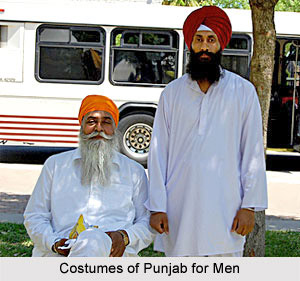 India is the land of colours the concept of eastern oriental charm gets ruefully heightened by the colour mavericks of costumes of Punjab. Costumes of Punjab are indicative of the dazzling and vibrant culture and lifestyle of the people of the region. The costumes are an amalgamation of colours, comfort and beauty. Punjab boasts of its use of Phulkari in its costumes a kind of flower work embroidery sewn most often on shawls worn over a tight-fitting Choli and Ghagra. Phulkari forms the archetypal traditional costume of rural women of this region and unlike the contemporary genre, phulkari used to be the daily garment of ladies. Usually the border and field of the shawl were not so densely embroidered, with much of the ground cloth exposed. Ceremonial festivities, witnesses the emergence of a special kind of Phulkari known as Bagh (garden) in which the whole of the ground was covered with embroidery which skilfully lurked the base cloth.
India is the land of colours the concept of eastern oriental charm gets ruefully heightened by the colour mavericks of costumes of Punjab. Costumes of Punjab are indicative of the dazzling and vibrant culture and lifestyle of the people of the region. The costumes are an amalgamation of colours, comfort and beauty. Punjab boasts of its use of Phulkari in its costumes a kind of flower work embroidery sewn most often on shawls worn over a tight-fitting Choli and Ghagra. Phulkari forms the archetypal traditional costume of rural women of this region and unlike the contemporary genre, phulkari used to be the daily garment of ladies. Usually the border and field of the shawl were not so densely embroidered, with much of the ground cloth exposed. Ceremonial festivities, witnesses the emergence of a special kind of Phulkari known as Bagh (garden) in which the whole of the ground was covered with embroidery which skilfully lurked the base cloth.
Costumes of Punjabi Women
Churidar Kurta invariably worn by Punjabi women in actuality has paved the way for national globalization of this dress. This was traditionally the dress worn in Punjab, but is now worn almost everywhere, particularly among the younger generations with bright coloured dupattas. A Salwar Kameez has two pieces of clothes- the Kameez, or shirt that is the top piece; and the Salwar, (pants) or bottom piece. A Dupatta is a piece of colourful cloth that adorns the female neck like a scarf. Salwar Kameez`s and Dupattas come in a variety of colours and designs. The women can also be seen wearing shawls adorned with the beautiful Phulkari embroidery. The shawl is completely covered in thick silk embroidery and folk motifs done in jewel-tones on an ochre background.
 Costume of Punjabi Men
Costume of Punjabi Men
The traditional costume of the men of Punjab comprises Kurta Pyjama. The Kurta is a kind of loose shirt which is long and straight-cut. The Pyjamas are loose, baggy pants which are tied at the waist. Some men also wear the Kurta with the Lungi or Tehmat, which is a kind of sarong. During winters they can be seen wearing bright colourful sweaters. Some of the boys as well as the grown up men can be seen wearing loose pants or slacks with a collared shirt or t-shirt. The Sikhs among the Punjabis can be distinctly identified by their attire as they are obliged by religion to wear turbans, known as Pugg or Pagri.
Accessories for Punjabi Women
Punjabi women, as well as men, are often bedecked in gold. They adorn themselves with necklaces, bangles, rings, nose rings, ear rings, toe-rings, anklets and other ornaments to pin up the hair with. Sikh women and men are seen wearing the Kada, a steel bangle, at all times. After adolescence, and almost certainly after marriage, women are expected to wear traditional Indian clothing. However with modernism creeping in, this trend is rapidly changing and women rejoicing in wearing a variety of western wear. Jeans, Jackets, Trousers, Skirts and other form of western outfits has outshone the traditional attire by the women of modern Punjab.
Traditional Punjabi shoes, called Juttis, are extremely popular with men in both the rural and urban areas. They are very comfortable and also look very elegant. During the winter months, both the Punjabi men and women adorn a woollen shawl or a small blanket, over their chest and necks. The shawls, usually crafted by female members of the family, are exquisitely colourful and intricately designed.
The modern urban Punjabi men have also adopted the western dressing style and are equally at ease in a pair of jeans and t-shirt as they are in the Lungi and Kurta. For the purpose of formal wear, Punjabi men can also be seen wearing shirts and trousers.





















